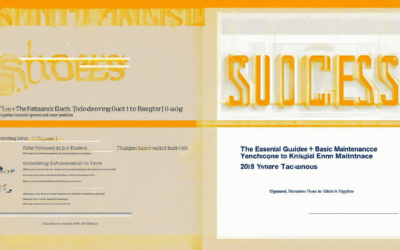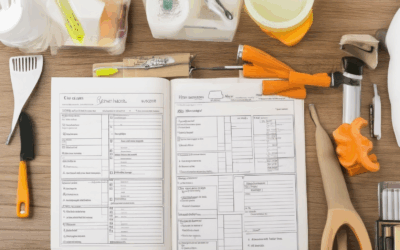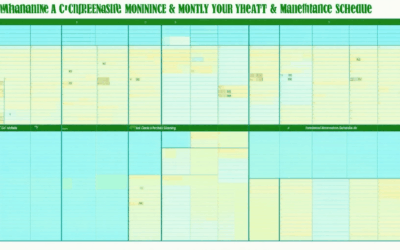Elevate Your Maintenance Game: A Comprehensive Preventative Maintenance Checklist Guide
Maintaining the health and longevity of your equipment, vehicles, or facilities requires a strategic approach that ensures everything runs smoothly. One of the most effective tools in achieving this is a well-crafted preventative maintenance checklist. By incorporating this essential document into your routine, you can optimize equipment performance, reduce the risk of unexpected breakdowns, and extend the lifespan of your assets. Whether you’re managing a fleet of vehicles, overseeing industrial machinery, or maintaining residential appliances, a thoughtful checklist can make all the difference in preserving efficiency and productivity.
This guide dives deep into the world of preventative maintenance, exploring its core concepts, essential components, and real-world applications. From understanding the basics to implementing effective strategies, we’ll cover everything you need to know to create and utilize a checklist that works for your unique situation. Discover how to streamline operations, minimize downtime, and ensure peak performance across various industries. With the right checklist in hand, you’ll be equipped to tackle maintenance tasks with confidence and precision.
Key Takeaways
- Prevent Unexpected Breakdowns: Use a comprehensive checklist and schedule regular inspections to avoid costly repairs.
- Extend Equipment Lifespan: Perform routine replacements and follow maintenance schedules to keep machinery running smoothly.
- Optimize Performance: Implement predictive analytics and conduct regular condition monitoring to maintain top efficiency.
- Reduce Downtime: Schedule maintenance and address issues early to keep operations running uninterrupted.
- Enhance Productivity: Train your team and ensure adherence to safety protocols for better workflow.
- Improve Efficiency: Utilize advanced tools like CMMS and maintain detailed records for better decision-making.
- Minimize Risks: Stay compliant with industry standards and prioritize worker safety.
- Ensure Reliable Operations: Regularly inspect and replace parts to maintain consistent performance.

What is a Preventive Maintenance Checklist?
A preventive maintenance checklist is a standardized list of tasks and procedures designed to ensure consistent and thorough completion of routine maintenance activities. It serves as a guide for technicians to systematically inspect, monitor, and service equipment or systems to prevent breakdowns, extend equipment lifespan, and optimize performance.
Key Components of a Preventive Maintenance Checklist
- Logbook: Maintain a record of all maintenance activities, including dates, times, and observations.
- Task List: Include specific tasks to be performed at each maintenance interval (daily, weekly, monthly, quarterly, annually).
- Checklist Items: Use checkmarks or notes to indicate completed tasks and identify areas needing attention.
- Pre-Maintenance Inspection: Conduct a quick visual check to identify and address minor issues before they escalate.
- Safety Protocols: Ensure all tasks are performed with proper Personal Protective Equipment (PPE) and adherence to safety guidelines.
- Issue Logging: Document any unusual noises, vibrations, or other signs of wear or damage for further evaluation.
Example Preventive Maintenance Checklist Structure
- Daily Checks:
- Oil level and dipstick check
- Fluid leaks or spills
- Belt tightness and wear
- Filter status (air, fuel, oil)
- Weekly Checks:
- Lubrication of moving parts
- Belt tension adjustment
- Exhaust system inspection
- Brake system test
- Monthly Checks:
- Oil and filter replacement
- Spark plug inspection
- Coolant level and condition
- Drive belt inspection
- Quarterly Checks:
- Cooling system maintenance
- Battery terminal inspection
- Steering and suspension components
- Fuel system inspection
- Annual Checks:
- Engine diagnostic check
- Transmission fluid and filter replacement
- AC/heat pump inspection
- Major component lubrication
Importance of Regular Updates
The checklist should be reviewed and updated periodically to reflect changes in equipment, new technologies, and evolving maintenance best practices. Regular updates ensure that the checklist remains effective and aligned with current standards.
By following a well-structured preventive maintenance checklist, organizations can significantly reduce downtime, extend equipment life, and enhance overall operational efficiency.
What Are the 4 Types of Preventive Maintenance?
Preventive maintenance is a crucial aspect of ensuring the longevity and efficiency of systems, appliances, and equipment. Here are the four primary types of preventive maintenance:
- Scheduled Preventive Maintenance : This involves regularly planned maintenance tasks performed at predetermined intervals. It ensures that issues are addressed before they escalate. Examples include changing oil filters, replacing worn parts, and cleaning or inspecting systems.
- Predictive Maintenance : This uses diagnostic tools and monitoring technologies to identify potential failures before they occur. It relies on data analysis and historical trends to predict when maintenance is needed. Common tools include vibration sensors and IoT-enabled devices.
- Random Preventive Maintenance : This involves randomly selecting equipment or systems for inspection and maintenance. It is often used when it’s impractical to monitor every piece of equipment continuously. For example, flipping switches or checking pipes at random intervals.
- Condition-Based Maintenance : This focuses on maintaining equipment based on its current condition. Sensors and monitors track factors like temperature, pressure, or wear and tear, and maintenance is performed only when these indicators suggest a problem.
Each type of preventive maintenance plays a vital role in optimizing performance and reducing downtime. Regularly scheduling these activities can save costs and extend the lifespan of your systems. For more detailed guides and resources, visit our home maintenance tips section or explore our DIY maintenance guides .

What is the 10 Rule of Preventive Maintenance?
The 10% Rule of Preventive Maintenance is a simple yet effective strategy to ensure your equipment and systems operate optimally. The rule states that all preventive maintenance activities should be completed within 10% of their scheduled due date . This approach helps in catching potential issues before they escalate and ensures that your assets are always in peak condition.
Why the 10% Rule Works
- Regular Check-Ups: Performing maintenance consistently helps identify and address problems early, which can prevent costly breakdowns later.
- Prolongs Equipment Life: By addressing issues promptly, you can extend the lifespan of your machinery and reduce the need for expensive replacements.
- Reduces Downtime: Predictive and planned maintenance minimizes unexpected failures, keeping your operations running smoothly.
Benefits of Adhering to the 10% Rule
- Extends the life of your equipment
- Prevents unexpected breakdowns
- Reduces maintenance costs
- Ensures optimal performance
- Minimizes downtime
By sticking to the 10% Rule, you can maintain a proactive approach to asset management, which is essential for long-term success. Remember, consistency is key when it comes to preventive maintenance.
For more resources on home maintenance and DIY projects, visit our website: Sam’s Maintenance .

What is Included in Preventive Maintenance?
Preventive maintenance encompasses a series of systematic actions taken to ensure the longevity, efficiency, and reliability of equipment or systems. Here’s a breakdown of what typically falls under preventive maintenance:
- Scheduling and Planning: Establishing a regular schedule for inspections, replacements, and servicing to prevent issues before they arise.
- Checklist Development: Creating detailed checklists that outline specific tasks to be performed during each maintenance interval.
- Maintenance Frequency: Determining the optimal intervals for tasks based on equipment type, usage, and age, such as monthly, quarterly, or annually.
- Types of Preventive Maintenance:
- Routine Maintenance: Scheduled tasks like oil changes, filter replacements, and belt checks.
- Predictive Maintenance: Using analytics and monitoring to identify potential issues before they cause downtime.
- Tools and Technology: Utilizing tools like CMMS (Computerized Maintenance Management Systems) to track and manage maintenance activities.
- Documentation: Keeping detailed records of all maintenance activities, inspections, and replacements for future reference and compliance purposes.
- Training Programs: Providing training for maintenance personnel to ensure they understand best practices and safety protocols.
- Compliance and Safety: Adhering to industry standards and safety regulations to minimize risks and ensure legal compliance.
By implementing these components, organizations can reduce downtime, extend equipment lifespan, and optimize operational performance. Effective preventive maintenance requires a combination of planning, execution, and continuous improvement to stay ahead of potential issues.
What Does a PM Consist Of?
A PM, or Preventive Maintenance, is a proactive approach to managing equipment and systems to ensure optimal performance and longevity. Here are the key components that make up a comprehensive PM program:
1. Predictive Analytics
At the core of effective PM lies predictive analytics. This technology analyzes historical data and operational conditions to forecast potential issues before they occur. By addressing problems early, organizations can significantly reduce downtime and extend asset life.
2. Condition Monitoring
Regular monitoring of equipment health through tools like vibration analysis, oil sampling, and thermal imaging helps identify deviations from normal operating conditions. Early detection allows for timely interventions, preventing minor issues from escalating into major failures.
3. Scheduled Maintenance
Scheduled maintenance ensures that equipment operates at peak efficiency by replacing worn components and performing necessary inspections. While often planned, these activities are critical for preventing unexpected breakdowns and ensuring smooth operations.
4. Human Intervention
Effective PM programs require skilled personnel to implement and oversee maintenance tasks. Roles include maintenance engineers, technicians, and supervisors who work to execute maintenance plans and resolve any issues that arise during the process.
5. Documentation and Records
Keeping detailed records of maintenance activities, including schedules, completed tasks, and asset histories, is essential for tracking progress and making informed decisions. This documentation also supports compliance with safety regulations and industry standards.
Conclusion
A well-executed PM program is vital for minimizing downtime, reducing costs, and maximizing productivity. By integrating advanced technologies and systematic approaches, organizations can ensure their assets operate reliably and efficiently for years to come.

What is Included in Routine Preventive Care?
Routine preventive care is essential for maintaining the health and longevity of your vehicle. Here’s a breakdown of what typically falls under routine preventive care:
- Oil Changes : Regularly changing the oil helps remove dirt and debris, preventing sludge buildup and maintaining lubrication.
- Tire Maintenance : Checking tread depth, inflation levels, and rotating tires to ensure optimal performance and longevity.
- Brake Service : Inspecting brake pads, rotors, and fluid levels to ensure effective braking and prevent wear.
- Filter Replacement : Replacing air and fuel filters to maintain engine efficiency and prevent contamination.
- Belts and Hoses : Examining drive belts and cooling system hoses for cracks, wear, or leaks to prevent mechanical failure.
- Fluid Levels : Checking transmission fluid, coolant, and other fluids to ensure proper functioning and prevent damage from low levels.
- Light Bulb Check : Inspecting and replacing worn-out bulbs for safety and functionality.
- Battery Health : Testing battery charge and terminals for corrosion to prevent unexpected failures.
- Vehicle Inspection : Looking for signs of wear, damage, or loose components to address potential issues early.
Scheduling regular preventive care services can significantly extend the life of your vehicle and reduce repair costs in the long run. Always refer to your owner’s manual for specific recommendations tailored to your car’s make and model.




0 Comments